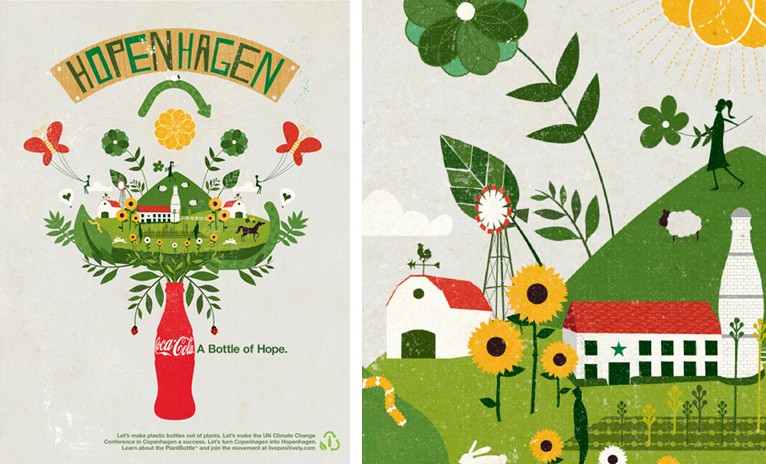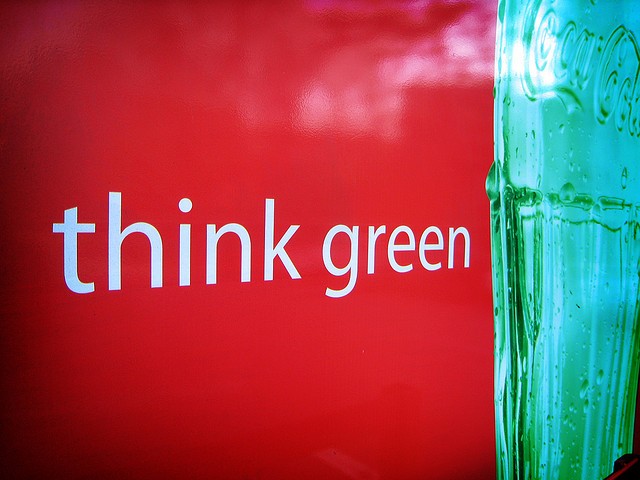CocaCola How a Large Multinational Corporation Goes Green
Post on: 23 Май, 2015 No Comment

When talking about Coca-Cola, youre talking about 300 different companies in over 200 countries with over 1 million employees. Youre talking about a balance sheet larger than most nations GDPs. It is a massive organism, and when things start changing at a place like that, the ripple effects can be powerful and many.
From hokey ads in the 70s that promoted recycling and diversity to being one of the first CPG companies to introduce recycled content into packaging in the early 90s, Coke has always recognized their connection to consumers and the communities around them. Throughout the world.
However, these praiseworthy elements have for a long time been mired by scandal, with lawsuits like this one contributing to the conventional wisdom that large, multinational corporations destroy local economies, communities, and habitats. And with an increasing preponderance of the latter, up until recently, many said the company had lost its way .
In 2004, the CEO at the time, Neville Isdell, recognized that something needed to change. And fast. He wanted to put the ugly baby on the table, according to Jeff Seabright, Coca-Colas Director of Environment & Water Resources. Isdell wanted to expose all that was working wrong for the company and reconnect with the ethos of the company: Coke is a provider of refreshment (and he was referring to more than just selling cold sodas).
Isdell created the Manifesto for Growth, which included what the companys leaders termed the 5Ps. They are guiding light principles for thinking about business, given that amongst other things, Coca-Colas relationships with its customers, the environment, and local communities are integral to the companys success. The 5Ps are:
1) People
2) Portfolio
3) Profit
4) Partnership
5) Planet
Very similar to triple bottom line thinking, all are immutable and interconnected. Leadership and improvement in terms of one P will bring about leadership and improvement with the others. Aligning business practices with these new principles meant, however, redefining the companys operations across the board, from working with its bottlers to where and how it sources water to how it gets it products to you, the customer. As Seabright reiterated many times in a recent interview, Coca-Cola is not just the four walls of the plant.
How Coca-Cola Sources Water
Water is a huge issue in terms of environmental and social challenges, as well as for operations, said Seabright. It is a non-debatable requirement to be in business. It is an essential element to its products. Without water, thered be no Coke or Fanta or Vitamin Water; however, sourcing water can have very large strains, especially in agricultural regions that have tendencies to be drought prone. To address and limit its impact, it has created a strong ethic of local engagement. The company has put systems in places in plants to clean and return gray and black water that is used in bottling operations to local habitats. It has also set goals and targets to offset its water impact from that which actually goes into its products, focusing beyond its particular plants to larger community levels.
As Seabright continued, Big companies can afford to dedicate resources and expertise to address issues to create co-habitation at micro-levels.
Several initiatives have been put into place throughout the world to create that co-habitation Seabright talks about, from rainwater harvesting to subsidizing drip irrigation techniques and technologies to working with local municipalities and farmers. It seems that the company not only wants to become more efficient in their water usage, but to help bring best practices and innovation to those around them, because ultimately more efficient practices that benefit the community also benefit Coke.
Sustainable Packaging and Beefing Up Standards
20Recycle.jpg /% If water is intrinsic to Coca-Cola products, so too is packaging and storage. The company has always recognized the importance of recycling and reclamation of the bottles (it was the first company in the CPG space to do perform a life-cycle analysis on packaging in 1969), but it also recently began addressing the bottles themselves. Last month, it released its PlantBottle, which is comprised of 30% renewable materials from feed-stock resin. Initially piloted with the Dasani brand and soon Vitamin Water, a life-cycle analysis conducted by Imperial College of London indicates the PlantBottle reduces carbon emissions by up to 25 percent compared against petroleum-based PET bottles.
In addition to packaging, refrigeration has become a huge issue for Coca-Cola. Refrigeration is the largest contributor to the companys climate footprint. An initial target by Greenpeace for the use of refrigerants with HFCs, the company opened up to criticism instead of trying to fight it. It resultantly became an early adopter of the Montreal Protocol and his since dedicated over $40 million to research and development on new technologies to completely do away with HFCs and CFCs.
By the end of 2008, the company and its bottling partners deployed more than 30,000 units of HFC-free equipment that uses CO2 as a refrigerantaccording to the Coke, a more eco-friendly alternative, with 1,400 times less potent GHG emissions than HFCs. It also intends to purchase and put into service 100,000 coolers that use CO2 refrigeration systems by end of 2010. This is the largest deployment of CO2 refrigeration by anyone in the commercial industry. Though CO2 equipment is currently considerably more expensive than alternatives, the companys leadership in this respect is driving other companies to follow suit, understanding that the industry must change in order to make a sizeable impact. It also teamed with Unilever and McDonalds to create Refrigerants, Naturally! an industry-wide initiative to move towards natural refrigerants, like butane and CO2, according to Seabright. Pepsi, Carlsberg, and Ikea have all since joined the initiative as well.
Green Teams at Coke

With so much sustainability being incorporated into the operations and business of Coca-Cola, how has the organizational culture changed? There has been a big attempt to communicate all of the companys sustainability initiatives, both to the public, but equally important, to its over 1 million employees. Coke wants to develop employees that are aware, educated, and enabled, says Seabright. From water issues to packaging to philanthropy, at some point, the executives at Coca-Cola realized that communication is almost as important as becoming better environmental stewards, discussing not what they are doing but why they are doing it. It is the companys belief that one of the biggest tools they have for effective communication is their employee base and their ability to serve as global ambassadors.
From internal blogging throughout the company-wide intranet to Coca-Cola University, the company provides employees with opportunities for training and further education, so that active participation around sustainability can start at the top and strengthen its foundation as it trickles down to the lowest rung on the corporate ladder.
Keys to Sustainable Growth: Setting Targets and Creating Partnerships
20Revives%20Sustains.jpg /%One can look at something like the PlantBottle and be critical about the companys commitment to it. They claim to be working towards making the bottle, which is 30% comprised of renewable sources, completely renewable. But why only the Dasani and Vitamin Water lines and not across the entire portfolio? Granted, it is one of the largest corporations out there, and implementing change takes time. And a lot of logistics. Not to mention dealing with food/fuel issues and sourcing existing sugar cane rather than planting new stocks, which company officials say they are working to address.
No one can deny that Coca-Colas existence inevitably means some sort of environmental impactits unfortunately a given that products will end up in landfills and garbage patches in oceansbut whats important to note about Coca-Colas relationship to the environment and the world around it is its recognition. It recognizes its size, and more importantly, the potential for power and influence that size brings (both positive and negative). It recognizes its ability (and perhaps, necessity) to change. As Seabright mentioned above, one of the great things large multinationals have is resources. And when big companies start incorporating sustainability ethics into their practicesalbeit economically motivated or from a more magnanimous placethey have the power to led the way and set the standard.
But where do you start? For Coca-Cola, that start came with forging partnerships. Coca-Cola first partnered with the WWF to attempt to address its environmental impact in places like India, Brazil, and Mexico. In examining the particular cases, they realized that much larger targets and goals needed to be created. It was a good push, said Seabright. A push that was welcomed.
For example, in terms of water, what started off as a commitment to become 20% more water efficient in 2012 than in 2004, quickly evolved into something much broader. WWF helped Coke realize it also needed to be giving back drops. We needed to give back to nature the amount of water we use, said Seabright. In 2007, Coca-Cola used 300 billion liters of water across the board. 120 billion liters went out as part of product, and 180 billion went into operations. By 2010, the company wants to clean and return all water that is used in operations. In addition, it wants to increase its support of drip irrigation, rainwater harvesting, and rainforest preservation, so that they are helping to save as much as water as what goes into their products.
Effectively, Coca-Cola wants to be a net-zero water consumer. Its an ambitious, but realistic goal.
These arent just bolt-ons for PR, added Seabright. Things like water stewardship and efficient packaging are intrinsic to operations and sound business strategies. And partnering with third parties like the Nature Conservancy and the WWF not only validate the seriousness of their efforts, they also provide expertise and address challenges a company like Coca-Cola may not be able to on its own. Most importantly, they provide pushes. And those pushes will provide subsequent pushes to smaller companies who look to the Coca-Colas of the world to provide leadership.














